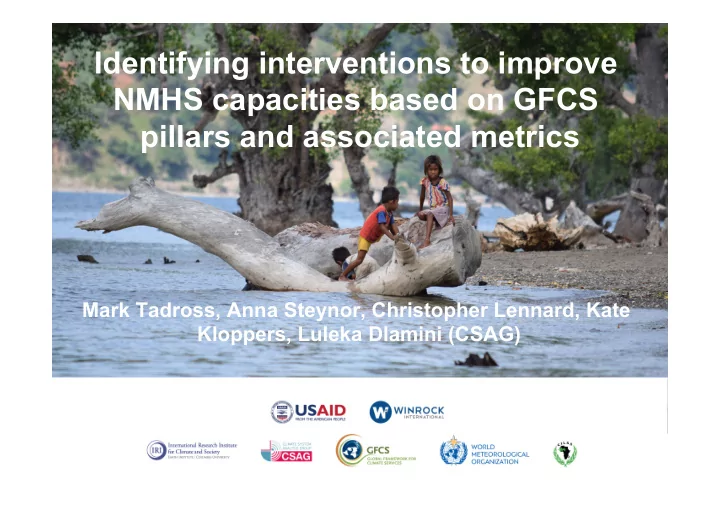

Identifying interventions to improve NMHS capacities based on GFCS pillars and associated metrics Mark Tadross, Anna Steynor, Christopher Lennard, Kate Kloppers, Luleka Dlamini (CSAG)
Methodological steps assessing capacity Metrics associated with each Situation/baseline GFCS pillar used to categorise assessment ; identify NMHS: 1 (basic), 2 (essential) NMHS existing capacities and 3 (full) within GFCS pillars Recommended capacities: Prioritization of essential capacities required for capacity needs current category, and desirable based on their capacities : those required for the impact and feasibility subsequent category Identify interventions to assist in the achievement of each prioritized capacity need
Observations and monitoring (metrics: surface and upper air monitoring, data QA/QC, data rescue, remote sensing) GFCS Pillar NMHS Senegal Cote Niger Mali Rwanda Ethiopia Malawi Category d’Ivoir 1 Requirements 1 ObservaAons Requirements 2 & Monitoring Requirements 3 Common Weaknesses Suggested Interventions Density of upper-air observations Expand stations in key locations based on O&M costs/ impact Density of surface stations (except Expand based on O&M costs, function and key Rwanda) scientific regions e.g. high vs low altitudes WMO/GCOS/WIS data standards Training technicians and equipment for reporting Use of satellite data Satellite data low cost option to expand coverage for early warning and agrohydrological applications.
Research, modelling and predictions (participate in research, medium-term weather forecasts, disseminate climate outlooks, national weather/climate research, sub-seasonal forecast products) GFCS Pillar NMHS Senegal Cote Niger Mali Rwanda Ethiopia Malawi Category d’Ivoir 2 Research Requirements 1 modelling Requirements 2 and Requirements 3 predicAons Common Weaknesses Suggested Interventions Seasonal temperature outlooks Include statistical and/or dynamical forecasts Number of PhD researchers Increase available bursaries and staff Access to downscaling tools Training on statistical/dynamic methods (depending on existing capacity) Access to sufficient bandwidth Increase bandwidth to min 10 Mbs -1
Climate Services Information System (advanced statistical analyses, climate watch & EWS, feedback from users, multidisciplinary and tailored analyses, NAP and policy relevant info.) GFCS Pillar NMHS Senegal Cote Niger Mali Rwanda Ethiopia Malawi Category d’Ivoir 3 Climate Requirements 1 services Requirements 2 informaAon Requirements 3 system Common Weaknesses Suggested Interventions Software and production climate statistics Training on open source (R, python) tools (depending on existing software) Data homogeneity testing Use changepoint analyses on data e.g. Rtest Webpages don’t have tailored products Engage IT/web design developer Advanced products on all timescales Training on visualisation & combining climate with other environmental data
User Interface Platform (interact and get feedback from users, identify user requirements, assist in interpretation, assist with info for risk management and transfer) GFCS Pillar NMHS Senegal Cote Niger Mali Rwanda Ethiopia Malawi Category d’Ivoir 4 User Requirements 1 Interface Requirements 2 plaJorm Requirements 3 Common Weaknesses Suggested Interventions Documenting user feedback Setup online and mobile-based procedures Formalised product redesign procedures Introduce SOPs for product redesign MoU/partners and develop tailored products Formalise collaborations with user-orientated organisations Users have access to website/API interface Provide website and APIs to collected data
Capacity development (trained technicians, forecasters, and management; NHMS legislation and policy participation; access to internet, hardware and software) GFCS Pillar NMHS Senegal Cote Niger Mali Rwanda Ethiopia Malawi Category d’Ivoir 5 Capacity Requirements 1 development Requirements 2 Requirements 3 Common Weaknesses Suggested Interventions Participation in national policies Engage young staff in DRR, NAP and NAMA platforms Staff training protocols Develop training framework (types of training, refresher courses etc) Train mid-level technicians Courses at Universities/regional training centres Diversify staff specialties Recruit from a wider range of backgrounds
Detailed interventions for each country based on essential and desirable capacities Pillar Existing Recommended Capacities category Essential Suggested intervention Desirable Capacities (would Suggested intervention Capacities (would fulfil the requirements for the fulfil the next category up) requirements of their current category) 1 4: User Formal training in Training or recruitment of Document user feedbacks Document in writing user feedback to interface engaging with an extension officer or and use those feedback to a s s e s s t h e u s e f u l n e s s a n d Platform users improve products climate service specialist effectiveness of the information and services provided. Provide a facilitated environment in which Establish procedures to incorporate forecasters and user feedback into the redesign of representatives from the climate information products and user communities are able services and the development of new products and services. to discuss forecast needs and products Documentation (in Create an internal Development of website, API Recruit staff with requisite skill set to and mobile network tools writing) of user Frequently Asked facilitate good internet presence of the feedback forecast products of the NMHS Questions repository of user questions and comments
Consistent interventions relevant to most NMHSs. Expansion of weather monitoring networks. l (a) Expansion of observation networks, QA/QC, sustainable O&M mechanisms; (b) standard and accessible databases of observations; l Equipment choice based on required use e.g. for early warning accuracy less important than timeliness. Implication on costs and O&M; Medium range forecasts l Improved bandwidth for downloading boundary conditions; l Using Model Output Statistics (MOS) with existing station data. Interacting with users l Dedicated staff to work with users and develop tailored products; l Establish research capacity to revise/redesign/test products; l Use of web/mobile communications for dissemination and feedback.
Limitations of the analysis l Weighting of each metric – reflects prioritisation of particular capacities; l Definition of thresholds for ‘fully met’ and ‘partially met’ criteria; l More emphasis on quantitative criteria which are easier to measure/value; l Difficult to measure institutional capacity and sustainability – ability to deal with staff turnover and development
Key messages l T he scores/numbers are not so important, rather whether we are capturing the right measures (identify right interventions, monitoring progress) ; l Several intervention options exist to address each weakness. Implies a flexible approach based on country context (staff resources/skills, funds) ; Thank you !
Recommend
More recommend